
Japan has a lot of rain, healthy water, and an abundance of vegetables and edible wild plants all year round. Essential nutrients such as vitamins are easily obtained from the local water and vegetables and, as a result, fruit has come to be considered a luxury good. It is often given as a gift on special occasions and is grown with exquisite care and attention to detail.
The qualities of Japanese fruit and vegetables are increasingly being recognized and more popular with consumers in other countries. Since 2013 we have been exporting our best products to satisfy this new overseas demand.
On this page we present some of best fruit and vegetables available for export to our overseas customers.
Fruits
Crown Melon

The Crown Melon is known as the “King of Fruit” and is one the best-known Japanese Premium Fruits overseas. It is grown in only a few places, one of which is Fukuroi, in Shizuoka prefecture where 600 farmers strive to produce perfect melons in all year round.
They use 20 different kinds of seed. These were developed by the Crown Melon Cooperative over many years. Every year the new seeds are carefully selected to improve the strain.
The farmers trim the vines so that only three melons grow on each tree. When the baby melons have grown to the size of a human fist, two are chopped off to allow the most promising one to take all the nourishment from the vine.
Citrus Fruit
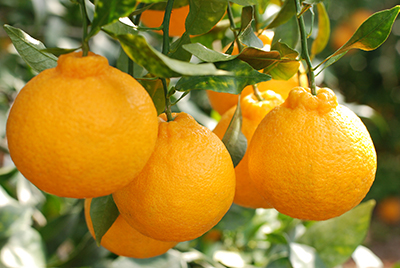
Mikan
The Japanese “Mikan” is a citrus fruit which is well known throughout the world and is sometimes called “Satuma” in other countries. It features a rind that is easier to peel off than an orange and because it is seedless easy to eat. The production quantity is ranked at the top among Japanese fruits. It is roughly classified into two types, the early variety “Wase” and regular.
The season differs according to the type of Mikan. The Wase type usually appears on the market from September to December while the regular type appears from January to February. Mikan cultivated in greenhouses appears on the market from April to October.
Dekopon
As the new merchandizing of late citrus fruits, the production and consumption of “Dekopon” has been growing during the past few years. In addition to the peculiarity of its appearance where the calyx swells and easy to peel off its rind, the juice is rich in flavor and the expectation of increasing the possibility of further future consumption is great.
Dekopon is a crossbred variety from “Kiyomi” and “Ponkan” citrus fruits. The rind is thin and easy to peel and the juice is rich. The sugar content must be 13 degrees or more to qualify as Decopon.
The period when it appears on the market is from December to April. Decopon grown in heat regulated greenhouses appears from December to January while the non-heat regulated ones in February and the outdoor raised ones from March to April.
Amao Strawberries
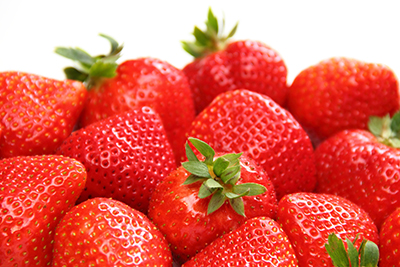
“Amao” is big in size and both the appearance and taste are good. This remarkable brand made its debut on a full scale in 2003. The features of the Amao strawberry are its red color, round shape, large size and delicious taste. It has been rapidly growing in popularity.
Peachs
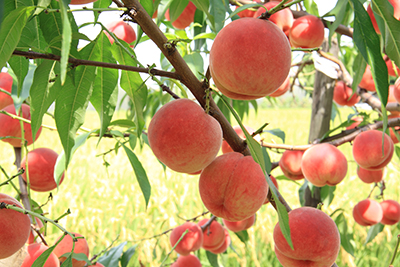
Hakuho class
As the main summer fruit item for a short period, the consumption for “Hakuho” has an enviable position among other peaches. The Hakuho class is harvested mainly in the first half of the peach season. It forms 18% of the yield for peaches. Hikawa Hakuho discovered this peach in Yamanashi prefecture and is superior in quality and can be stored for a long time. The season when it is available on the market depends on the class but it is usually from the middle to the end of July.
Hakuto class
The “Hakuto” class is harvested mainly towards the latter half of peach season. The representative class, “Kawanakajima Hakuto” was discovered when it was grown by chance in Nagano prefecture and later named in 1977. It can be stored for a long time and ripens late. The flesh is harder than the Hakuho class and the juice is rich. The season is different depending on its class; however, it appears at the end of August through to September.
Grapes
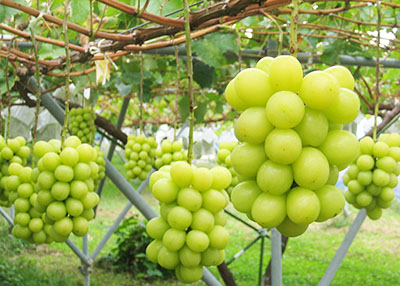
Shine Muscut
“Shine Muscat” is a new variety registered in 2003 and rapidly increasing in popularity. It is a seedless grape with the refreshing fragrance of Muscat of Alexandria and has high sugar content. The shipment period is from May to late October.
Seedless Kyoho
“Kyoho” forms 34% of the yield total of grapes. The perceived impression as a high-class grape still prevails today; however, due to the increase of production quantity, it is currently sold actively in volume sales shops and consumption continues to grow. It is at the top position among Japanese grape brands. The rind is purple black. It has rich juice, high sugar content and the taste is superb. The shipment period is from August to October. The peak season is in September.
Apples
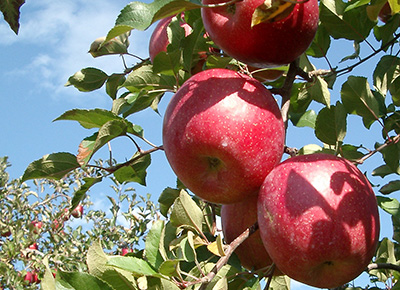
Tsugaru
“Tsugaru” forms 13% of apple production quantity in Japan and is cultivated next to the “Fuji” type apple. Tsugaru is an early season variety of good tasting apples and we observe increasing production and stable consumption. It is also cultivated without covers and appears on the market as “Sun Tsugaru”.
Tsugaru’s shape is round and well-proportioned. The flesh quality is fine and rich in juice without much acidity. The harvest period is from the middle of August to October.
Fuji
“Fuji” forms 55% of the harvest quantity and is the representative brand of Japanese apples. It was named and registered in 1962. The rind is red brown and colored in stripes. It is juicy, very sweet, less sour and perfectly crunchy. Fiji is excellent for a long period of storage. Fuji is an apple of the late season variety and harvested from October to November. It is shipped until the following July due to CA (controlled atmosphere) storage. It is also cultivated without covers and appears on the market as “Sun Fuji”.
Orin
“Orin” forms approximately 10% of the apple yield. As a brand having peculiar fragrance and taste, the production and the consumption are growing. This brand is suitable for cultivation without covers and comparatively easy to produce for producers. The rind is yellow green. The texture has rough black spots.
The fragrance is strong, juice is rich and the taste is excellent. It has taken root as a late season variety. The storage property is fairly good and it can be stored until February. The harvest period is around October to November.
Kinsei
The consumption ratio of the “Kinsei” brand is not very high; however, because of the appealing appearance of its bright golden color, it is commonly bought as a gift. The bright yellow rind is its special feature. The flesh is rough, but is juicy. The sugar content is 13~18 degrees and it is sweet but not so sour. The fragrance is strong. The storage property is also excellent. The harvest period is the middle of November. Because the storage property is high it is possible to store until the end of the following May.
Mutsu
The consumption ratio by brand is low for “Mutsu”; however, as the size is big and the appearance is pretty, there is much demand for it as a gift and is called the “King of Apples”. The rind is yellow green when cultivated without a cover. However, when cultivated with a cover, its finished color is pink. It can be customized so that the Japanese character for ‘congratulations’ (“Kotobuki”) appears in yellow which is used for gifts and other occasions. The juice is rich and it has a unique fragrance. The harvest period is from the middle to the end of October. It has a long storage life and appears on the market from November to May.
Persimmons
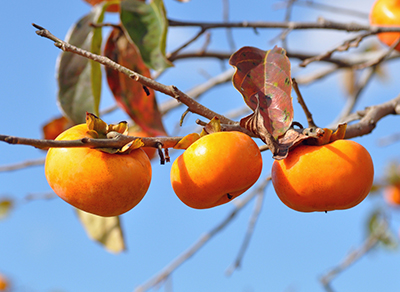
Hiratanenashi
“Hiratanenashi” is the representative class of astringent persimmon. It forms 15% of persimmon yield. It has different taste and flesh quality from sweet persimmons. As it is seedless, it is easy to eat. The demand for this class is good. The shape is flat round with a peculiar box form. The rind is bright orange yellow, smooth, glossy and appearance is good. The sugar content after removing the astringent element is about 14 ~ 16 degrees. The flesh is close, soft, and juice is rich. The astringent element removing process is performed normally with alcohol and carbonic acid gas. The peak of the season is from October to November.
Fuyu
Persimmon is a fruit tree cultivated from the old days and there are many classes in various areas. It is roughly classified into two groups, the sweet persimmon and astringent persimmon. The “Fuyu” class is representative of this fruit class and has been dominating the persimmon market for years. It forms 34% of the total yield of persimmon. The rind is orange red in color. It has a glossy skin and blooms frequently. The flesh is close and juice is rich. The sweetness level is medium. The storage property is good and some are stored in refrigerators. The period it appears on the market is from October to November. The ones stored in refrigerators appear from December to January.
Pears
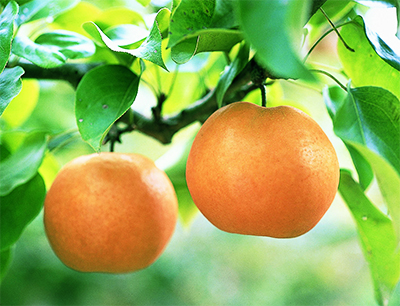
Kousui
“Kousui” forms 37% of the yield for Japanese pears. It is sweet and the production is increasing as a brand with rich juice. It has been established as the top ranking Japanese pear. The flesh is soft and has rich juice. The rind is a medium color among red pears. Its special feature is that it has a deep dented bottom. The sugar content is approximately 12 degrees.
The shipment period is from July to September. Greenhouse pears are shipped in early July and outdoor raised pears are shipped during mid to end of August. The peak of the season is from the end of August to early September.
Nijusseiki
Among Japanese pears, it is the representative brand of green pears which has a yellow green rind. It has a well-proportioned round shape. The flesh is fine and soft. The appearance becomes prettier when cultivated with covers. The harvest period is from the early to the end of September.
- Copyright©2014 Matsugen Co., Ltd. All Rights reserved.
